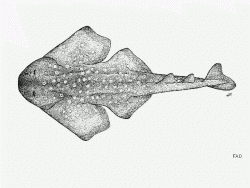select your film:


The Squatina Africana, also known as the African Angelshark, is a continental shelf and upper slope shark that occurs mainly in the Western Indian Ocean. This species belongs to the family of Squatinidae.
Biology:
The African Angelshark is greyish and reddish-brown with many light and dark spots, often large granular-centred ocelli in young. It has larger symmetrical dark bands or saddles, blotches on broad and angular high pectoral fins. The tail is a dark base with white margins, simple flat nasal barbels, tips tapering or spatulate. No angular lobes on lateral dermal flaps, thorns are enlarged on the head, not back. Concave between eyes. The maximum length is of 80 cm TL in males and 108 cm TL in females.
Reproduction:
This species is ovoviviparous, with about 7 to 11 pups in a litter. The size at birth rages from 28 to 34 cm. Embryos feed solely on the yolk. There is no information on age and growth.
Habitat:
Found in the continental shelf and uppermost slope, from the surf line to about 500 m depth. Its current distribution is widespread around the Western Indian Ocean. From East and southern Africa to Mozambique, Tanzania and Madagascar.
Behaviour:
This species usually lies buried to ambush their prey.
Conservation:
In South Africa, the species does not have any commercial value and is apparently little utilised. Their biggest potential threat is demersal trawling for prawns off the Tugela banks, this is both in terms of catches and habitat degradation by trawling. There are no current conservation actions for this species. The ongoing release of these animals from the trawl fishery and from the KZN shark nets should be encouraged.
Do you have images or videos of African Angelsharks?
Submit them to [email protected].
